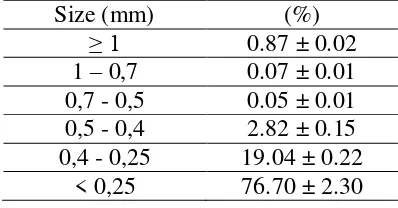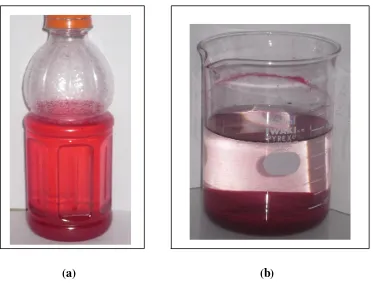AND NATURAL IRON COATED-SAND
PENGOLAHAN LIMBAH CAIR DARI INDUSTRI BATIK
DENGAN KOMBINASI ALUMINIUM SULFAT DAN
PASIR BESI ALAMI
Izarul Machdar* dan Wahyu Rinaldi
Jurusan Teknik Kimia, Fakultas Teknik, Universitas SyiahKuala
Jl. T. Nyak Arief, Darussalam, Banda Aceh 23111 *e-mail: machdar20@yahoo.com
Abstract
This paper presents the results of dye wastewater treatment of a batik industry in a batch experiment. The experiment was carried out by adding a mixture of aluminium sulfate as coagulant and natural iron oxide-coated sand (NICS) into the wastewater. Sedimentation rate of the formed flock was enhanced by a magnet. Initial COD concentration of the dye wastewater of 1060 mg/L was used in the experiment. Results of this research showed that the efficiency of the dye removal and settling time were affected by iron sand entrapped in the formed flocks. The highest efficiency of COD removal was 95%, or similar to the final COD concentration of 45 mg/L at settling time of 10 minutes. It could be concluded that the combination of aluminium sulfate and NICS could effectively be used in the treatment of the dye wastewater from batik industry.
Keywords:dye wastewater, coagulation, iron oxide-coated sand, batik industry
Abstrak
Artikel ini memberikan informasi mengenai pengolahan limbah cair zat warna dari industri batik di dalam suatu sistem batch. Penelitian dilakukan dengan mencampur koagulan alum dan pasir besi alam ke dalam limbah cair zat warna. Laju pengendapan flok yang terbentuk ditingkatkan dengan bantuan magnet. Nilai COD awal dari zat warna yang digunakan dalam eksperimen ini adalah 1060 mg/L. Hasil penelitian menunjukkan bahwa penyisihan zat warna dan waktu pengendapan dipengaruhi oleh penambahan pasir besi ke dalam flok yang terbentuk. Efisiensi penyisihan COD dari limbah zat warna yang paling tinggi diperoleh sekitar 95%, atau setara dengan konsentrasi akhir COD sebesar 45 mg/L, dengan waktu pengendapan 10 menit. Dari hasil ini dapat disimpulkan bahwa, kombinasi aluminium sulfat dan pasir besi alami dapat digunakan di dalam pengolahan limbah cair zat warna dari industri batik.
Kata kunci: air limbah zat warna, koagulasi, oksida besi berlapis pasir, industri batik
1. INDTRODUCTION
Batik is an ancient method of textile decora-tion, which has been practiced in many places all over Asia since prehistoric times. The na-mes of the tools and even the name "batik" were adopted from the Indonesian language. Batik means "drawing with wax" (Haake, 1989). In other reference, it is thought to be -
Batik manufacturing consumed a considerable amount of water in its manufacturing process. The water is primarily utilized in the dyeing and finishing operations. Dye-containing effluent is toxic to the environment since dyes are stable compounds, with low biodegra-dability and can be carcinogenic (Gregory, 1986). Dyes are normally very large aromatic molecules consisting of many linked rings. Three common dyes, classified according to the fibers to which they can be applied and their chemical nature are: (1) acid dyes; (2) reactive dyes; and (3) disperse dyes (Yang and McGarrahan, 2005). Biological treatment processes are frequently used to treat dye wastewater effluents. These processes are ge-nerally efficient for biochemical oxygen demand and suspended solids removal, but they are largely ineffective for removing color which is visible even at low concentrations (Slokar and Majcen, 1997; Banat, 1996). Therefore, other techniques or their combination must be applied.
cluding coagulation, flocculation, filtration and membrane adsorption, electro coagula-tion, are used to remove color from dye efflu-ents (Tores et al., 2010; El-Gohary and Tawfik, 2009). Removal of colour from tex-tile wastewater has been reviewed (Pearce at al., 2003). Coagulation/flocculation process is one of the most efficient methods that are widely employed for dye removal from industrial wastewater as it is efficient and simple to operate (Gao et al., 1997; Tan et al.,
2000; and Jiang et al., 1996). However, for high loading of dye wastewater, these systems need a relative high sedimentation tank. This paper describes application of aluminium sulfate as coagulant and NICS for pre-treat-ment of a dye containing effluent from a batik industry. The main objective of using the NICS is to increase a sedimentation time of formed flocks. The iron sand entrapped in the flock can be quickly isolated by a magnet. Mechanism of dye removal by combination of coagulant and iron coated-sand is presented in Figure 1.
Figure. 1. Mechanism Dye Removal Using Combination of Coagulant and NICS
2. METHODS
Dye Wastewater and Natural Iron-Coated Sand
The experiment was performed at laboratory scale and batch test. The dye wastewater
samples were collected from a batik industry at Banda Aceh City, Aceh Province. The key comp ositions of the wastewater are as follows: neutral pH and COD value of 1060 mg/L. A NICS (ferruginous sand) extracted from an iron ore located in District Dye wastewater + coagulant + iron coated-sand Magnetic floc
of Aceh Besar, Aceh Province. The NICS sample and fraction of the iron grain are presented in Figure 2 and Table 1 respectively. Size of the iron sand is reduced about 250 µm prior to application.
Dye Removal Tests
Jar tests were carried out to evaluate the efficiency of aluminum sulfate and NICS to reduce dye contaminant in the wastewater from a batik industry. Three hundreds mL dye wastewater was filled into each of six beakers of 1 L volume. Aluminium sulfate solution of 3 mM was added to each beaker. This optimum concentration of coagulant dose was based on a previous test with the jar test on similar dye wastewater. The dye wastewater samples were first agitated vigorously at 200 rpm for 3 min and subsequently mixed at a reduced speed of 90 rpm for 15 min as well as adding the NICS.
After coagulation, the samples were settled or magnated and then 50 mL aliquot was sampled from the clean top zone of the beaker for the measurement of residual COD. The treatment was replicated three times with similar condition.
Analytical Methods
COD was determined with a HACH DR-2000 model spectrophotometer. The NICS was characterized using SEM-EDAX (JEOL JSM-6390A). The scanning energy for EDAX analysis was performed from 0 to 21 keV with an elapse time of 80 s. For the NICS investigation, two samples were prepared with pre-treatment by heat at 250oC for one day and without pre-treatment.
Table 1. Particle Distribution of the NICS Sample
Size (mm) (%)
Characterizations of the Natural Iron Oxide-Coated
Process Performances
Table 3 demonstrates the sedimentation effect on the COD removal of the dye wastewater without treated by aluminium
coagulant. As the contact time was increased until 24 h, the final COD concentration achieved 89 mg/L (±17 mg/L), which was equivalent to COD removal of 91.6%.
Figure 2. NICS Used in this Study
Figure 3. SEM Photographs of the NICS (b) With Pre-heat Treatment
Figure 4. Representative of EDAX Spectra of the NICS Table 2. The Elemental Composition of the NICS
Element
Weight Percentage (%)
a B c d e f Average SD
C 7,7 3,8 3,3 4,4 4,4 3,9 4,6 1,6
O 39,2 32,9 33,5 37,6 33,4 30,9 34,6 3,1
Na 1,9 0,9 1,1 1,2 1,3 0,9 1,2 0,4
Mg 1,8 1,7 2,4 4,4 5,1 1,3 2,8 1,6
Al 7,5 2,2 4,3 5,0 3,5 3,2 4,3 1,8
Si 10,0 4,0 5,1 6,8 7,9 3,5 6,2 2,5
Cl 2,5 0,7 1,1 1,1 2,0 1,2 1,4 0,7
Ti 3,6 4,8 5,7 6,7 8,1 3,8 5,4 1,8
Fe 26,0 50,1 43,5 32,8 34,3 51,4 39,7 10,2
Note: a, b, c (sample without pre-heat treatment)
d, e, f (sample with pre-heat treatment) In order to achieve Indonesian effluent standards of wastewater from textile industry (i.e. 150 mgCOD/L according to
KepMen LH No.
KEP-51/MENLH/10/1995), it needs about 2 h for sedimentation. Although it is a relatively very short settling time, this
method is complicated to be applied in real situation. It is because the settled dye stuff is easy to re-dissolved in liquid media.
the dye will accumulate in flock formation. Adding the particles of NICS into the inner part of the flock, it resulted in complete precipitation
complete precipitation and settlement. From visual observation, the sand particle contained flock formation was not easy to redissolved. Table 4 shows that COD final concentration of
dye wastewater at treatment with different NICS dosages. Similarly, the aluminium sulfate dosage was fixed at 3 mM. When the dosage of the NICS
Table 3. Effect of Precipitation in COD Removal of the Dye Wastewater Duration of precipitation (h) COD (mg/L) Start 1060 (initial concentration)
2 118 ± 9
8 108 ± 12
16 97 ± 5
24 89 ± 17
Table 4. COD Removal by Combination of Aluminium Sulfate and NICS
wastewater treatment of batik industry. It might offer prospective application of reusing
the treated water and will significantly contribute to reduce fresh-water consumption.
Figure 5. Batik's Wastewater Before (a) and After (b) Treatment by Combination of NICS and Aluminium Sulfate.
ACKNOWLEDGEMENTS
The authors thank the Ministry of National Education for the Fundamental Research Fund, No. 008/SP2H/PP/DP2M/-III/2010. REFERENCES
Banat, I. M., Nigam, P., Singh, D., and Marchant, R. 1996. Microbial Decolo-rization of Textile-Dye Containing Effluent, Journal of Bioresource Tech-nology 58, pp. 217–227.
El-Gohary, F. and Tawfik, A. 2009. Decolorization and COD Reduction of Disperse and Reactive Dyes Wastewater Using Chemical-Coagulation Followed by Sequential Batch Reactor (SBR)
Process. Desalination. 249, pp. 1159– 1164.
Gao, B. Y., Wang, Y., Yue, Q.Y., Wei, J. C., and Li,Q. 2007. Color Removal From Simulated Dye Water and Actual Texti-le Wastewater Using a Composite Coagulant Prepared by Polyferric Chloride and Polydimethyldiallylammo-nium Chloride, Sep. Purif. Technol. 54, pp. 157–163.
Gregory, P. 1986. Azo dyes: Structure-Car-cinogenicity Relationships. Dyes Pig-ments. 7 (1), pp. 45–56.
Haake, A. (1989). The Role of Symmetry in Javanese Batik Patterns. Computers Math. Applic. Vol. 17, No. 4-6, pp. 815-826.
Jiang, J.Q. and Graham, N.J.D. 1996. Enhanced Coagulation Using Al/Fe(III) Coagulants: Effect of Coagulant Che-mistry on the Removal of Colour-Causing NOM, Environ. Technol. 17, pp. 937–950.
Kementerian Perindustrian, 2010. http://-www.kemenperin.go.id/ (access: 25 Oct. 2010).
Living in Indonesia 2010. A Site for Expatriats. http://www.expat.or.id/ (access: 25 October 2010).
Pearcea, C.I., Lloydb, J.R. and J.T. Guthriea, J.T. 2003. The Removal of Colour From Textile Wastewater Using Whole Bacterial Cells: a review. Dyes and Pigments. 58, pp. 179–196.
Slokar, Y.M. and Majcen, M. A. 1997. Methods of Decolorization of Textile Wastewater. Dyes and Pigments. 37 (4), pp. 335–356.
Tan, B. H., Teng, T.T., and Omar, A.K.M. 2000. Removal of Dyes and Industrial Dye Wastes by Magnesium Chloride.
Water Res. 34, pp. 597–601.
Torres Riera, M., Gutiérrez-Bouzán, C., and Crespi, M. 2010. Combination of Coagulation Flocculation and Nanofil-tration Techniques for Dye Removal and Water Reuse in Textile Effluents.
Desalination. 252, pp. 53–59.





